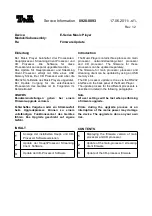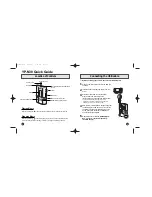
91
En
Connection/etc.
Aspect
Aspect ratio refers to the length to height ratio of TV screens.
The ratio of a normal TV is 4:3, while the ratio of a Hi-vision
TV or wide TV is 16:9. This allows you to enjoy a picture with
a wider perspective.
Component video output
The color signal of the TV is divided into the luminance (Y)
signal and the color (P
B
and P
R
) signals and then output. In
this way mutual interference of each signal is avoided. On a
TV with component input jacks, these signals are synthesized
to produce the picture.
Parental level
This function was suggested by parents. Parental level con-
trol are restrictions incorporated into scenes that allow par-
ents to prevent their children from viewing them if they desire.
Dynamic range
Dynamic range refers to the difference between the maximum
and minimum levels of the audio soundtrack as measured in
decibels (dB).
Dolby Digital
The maximum 5.1 channels of audio used in the surround
system (Surround Digital) for movie theaters is digital data
compressed by AC-3.
For DVD discs, the digital output PCM/
jack must be con-
nected to the amplifier or processor’s digital input AC-3/PCM
jack.
Playback Control (PBC)
This refers to signals recorded on a Video CD (Version 2.0)
enabling playback control.
You can use menus recorded on discs with PBC for easy, in-
teractive search for desired scenes and playback.
You can also enjoy viewing high-resolution/standard resolu-
tion still images.
Multi-angle
When you watch regular TV programs you are watching the
image filmed through the TV camera. Because of this, the
picture is displayed on your TV from the view point of the TV
camera’s position. In a TV studio the image is filmed by many
cameras at the same time. One of those images is selected
by the program director and transmitted to your TV. If all the
filmed images were transmitted to your TV you would be able
to select the camera image you want. Some DVD discs are
recorded with the angles of all the camera’s used for filming
and you can select among them when using this player. These
types of discs are called multi-angle discs.
Multi-audio
Some DVD has multi audio language.
Up to eight different languages (8 streams) can be recorded
on a DVD disc, The multi audio function can be used to select
the language of your choice.
Subtitle
Subtitles are language titles superimposed on movies etc. Up
to 32 different subtitle languages can be recorded on a DVD
disc. The subtitle function can be used to select the language
of your choice.
Regional restriction codes (Region number)
Regional restriction codes are built in to DVD players and DVD
discs for each sales region. If the regional restriction codes of
the DVD player does not match one of the regional restriction
codes of the DVD disc, playback is not possible.
The regional restriction code can be found on the rear panel
of the DVD player. The illustration below shows the regions
and corresponding region numbers.
Linear PCM
This refers to DVD audio recording format. It is the same for-
mat as that of CD audio, but the sampling frequency is re-
corded at 48 kHz and 96 kHz, and audio with a higher sound
quality than that of a CD can be enjoyed.
DTS
DTS stand for Digital Theater System. DTS is a surround sys-
tem different from Dolby Digital that has become a popular
surround format for movies.
MPEG
MPEG stand for Moving Picture Expert Group. This is an in-
ternational standard for compression of moving images. On
some DVDs, digittal audio has been compressed and recorded
in this format.
PCM
PCM stands for Pulse Code Modulation and is digital audio.
The digital audio of CD or DVD discs is PCM.
5.1 ch
This refers to multi-channel audio with a special low sound
range 0.1 channel added to the five channels of front left/right,
center and rear left/right. It is used by the Dolby Digital and
DTS surround systems.
Terms
DOLBY
D I G I T A L
Содержание NextWindow DVD-V7300D
Страница 1: ...1 En Operating Instructions DVD PLAYER DVD V7300D ...
Страница 95: ...95 En Connection etc ...






































